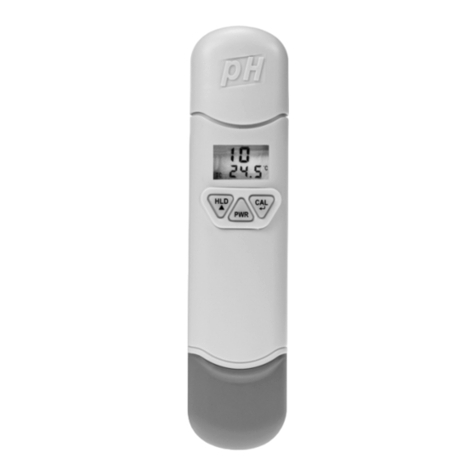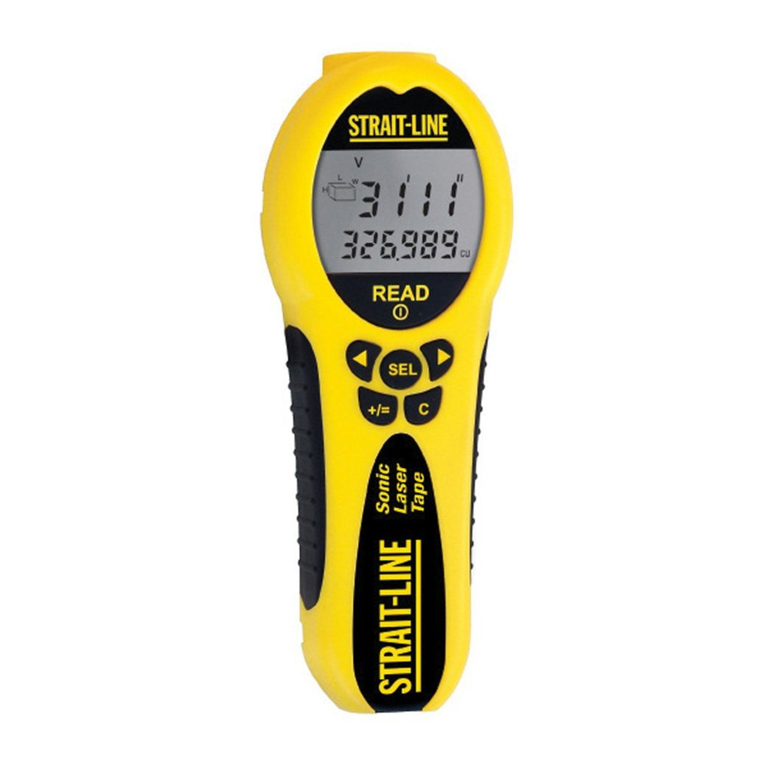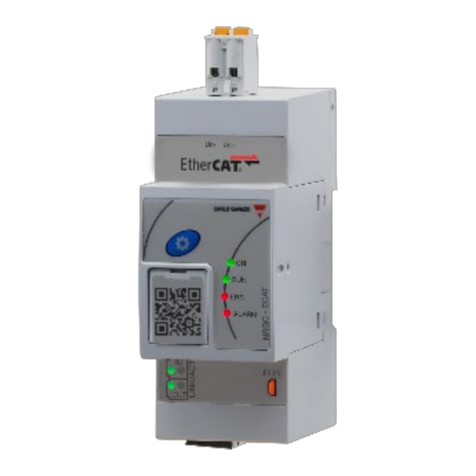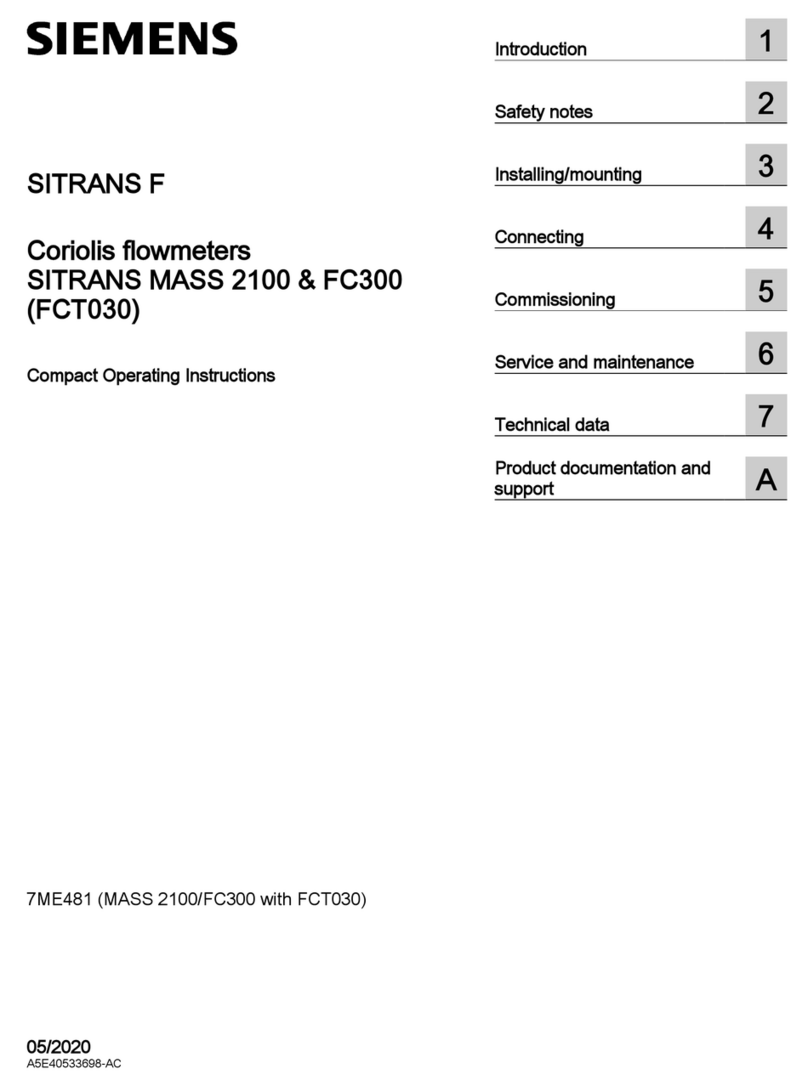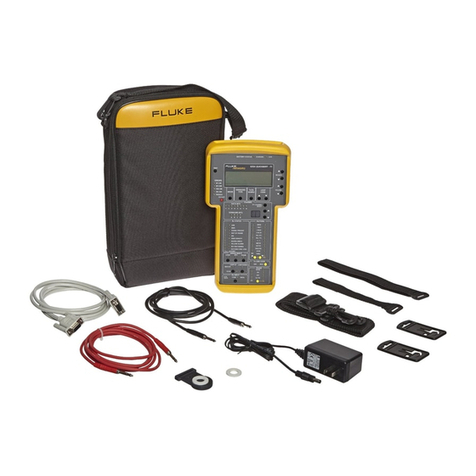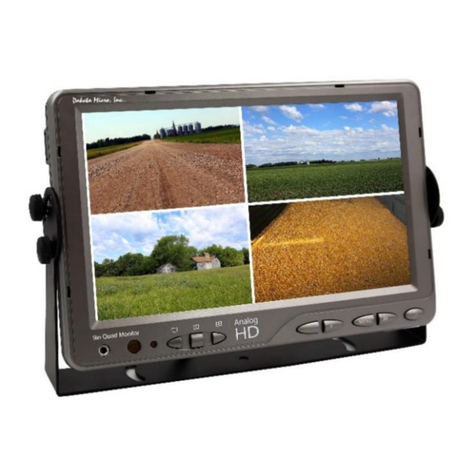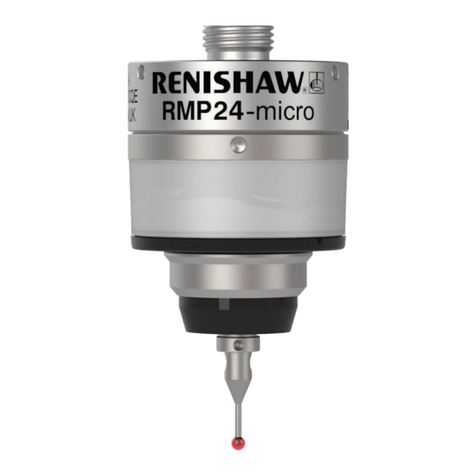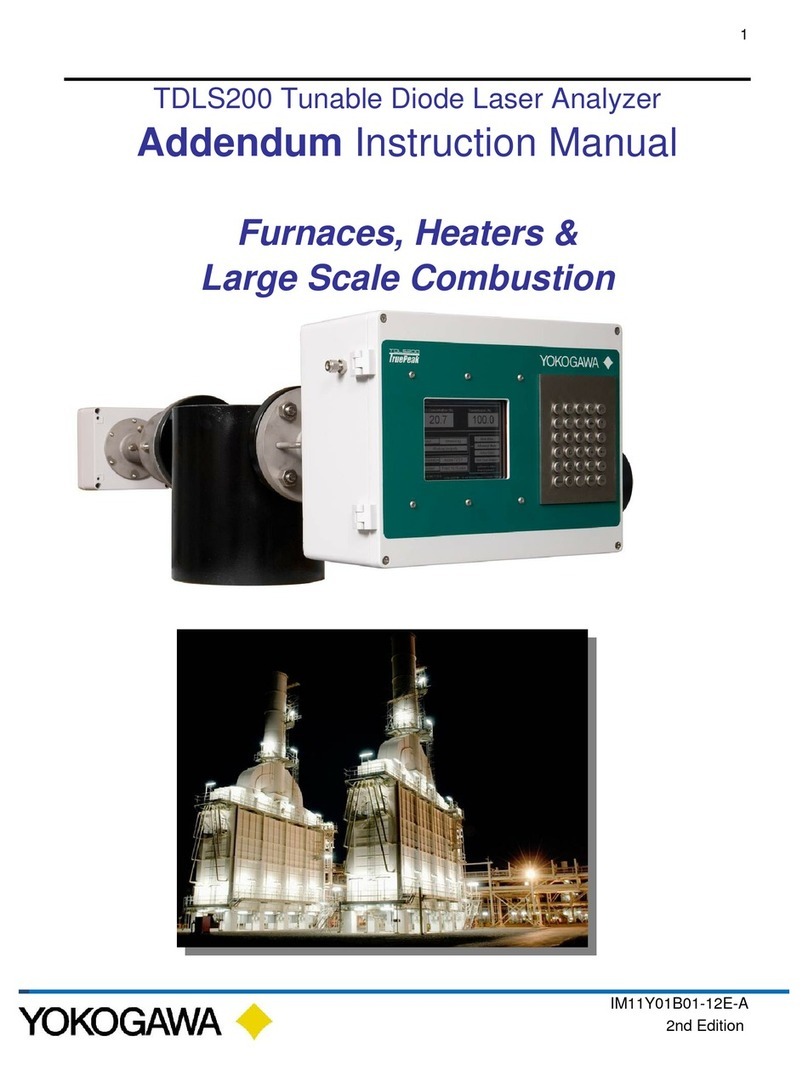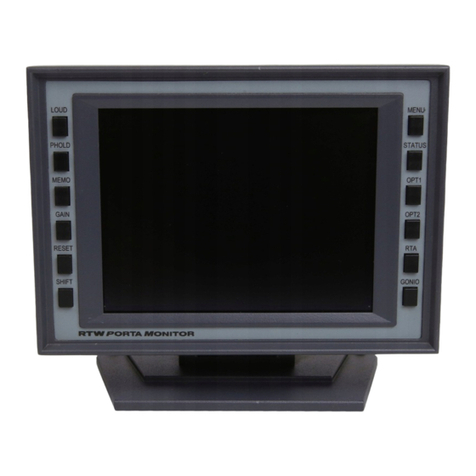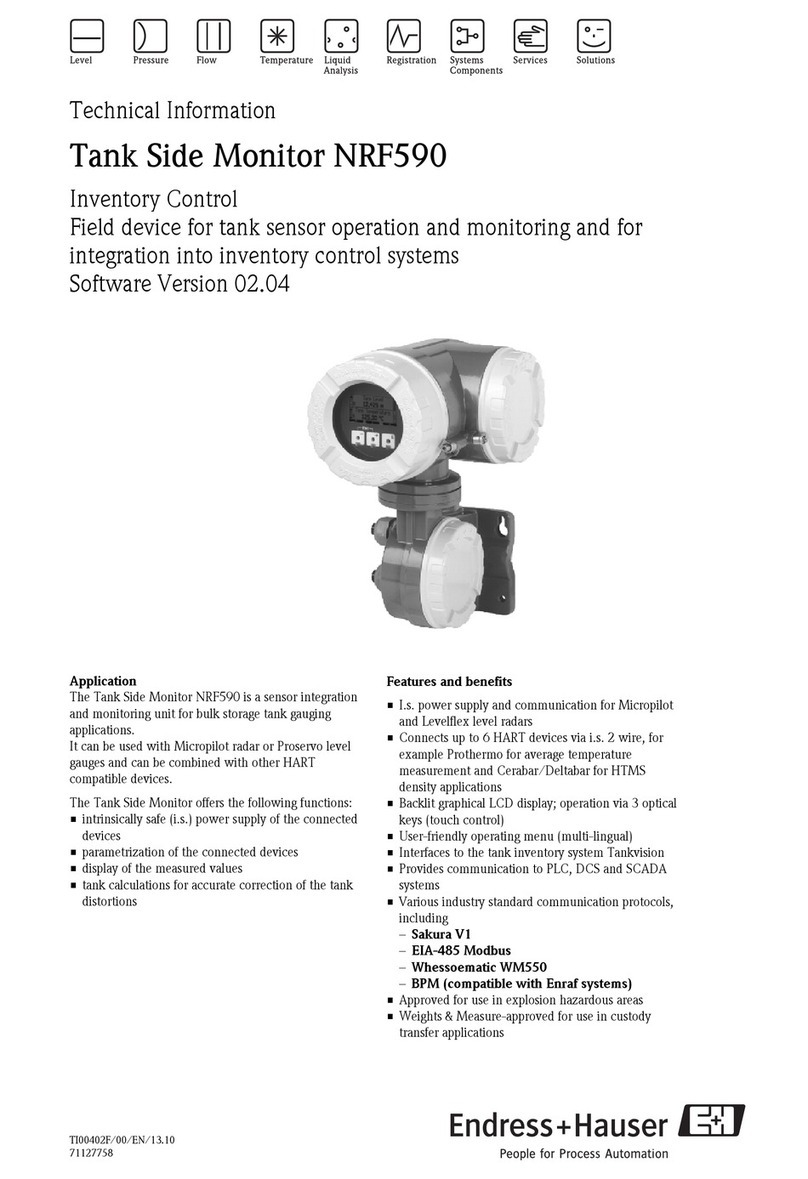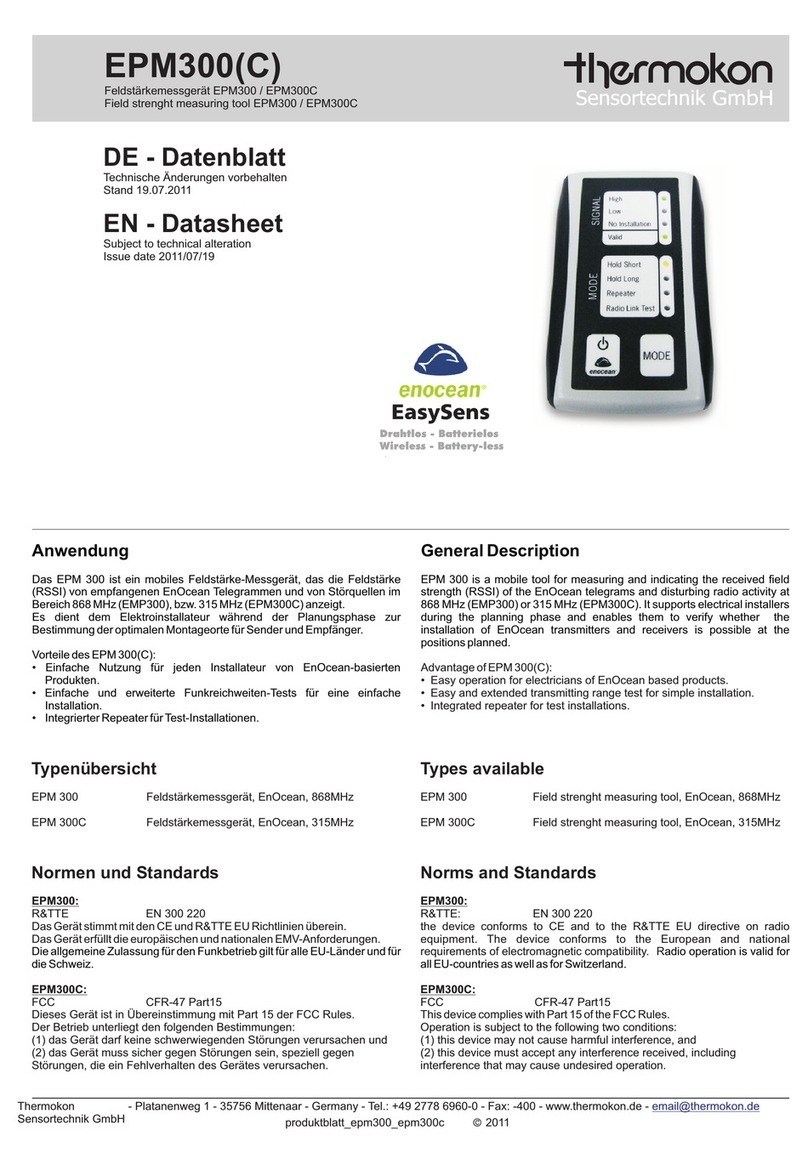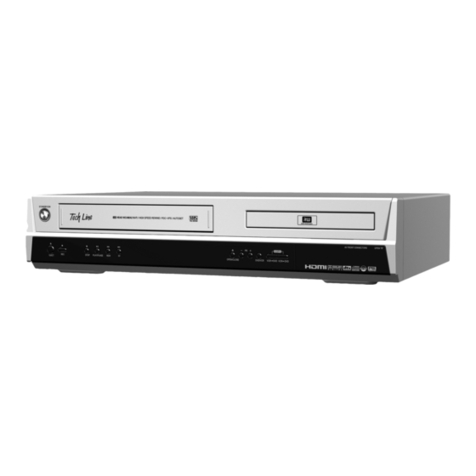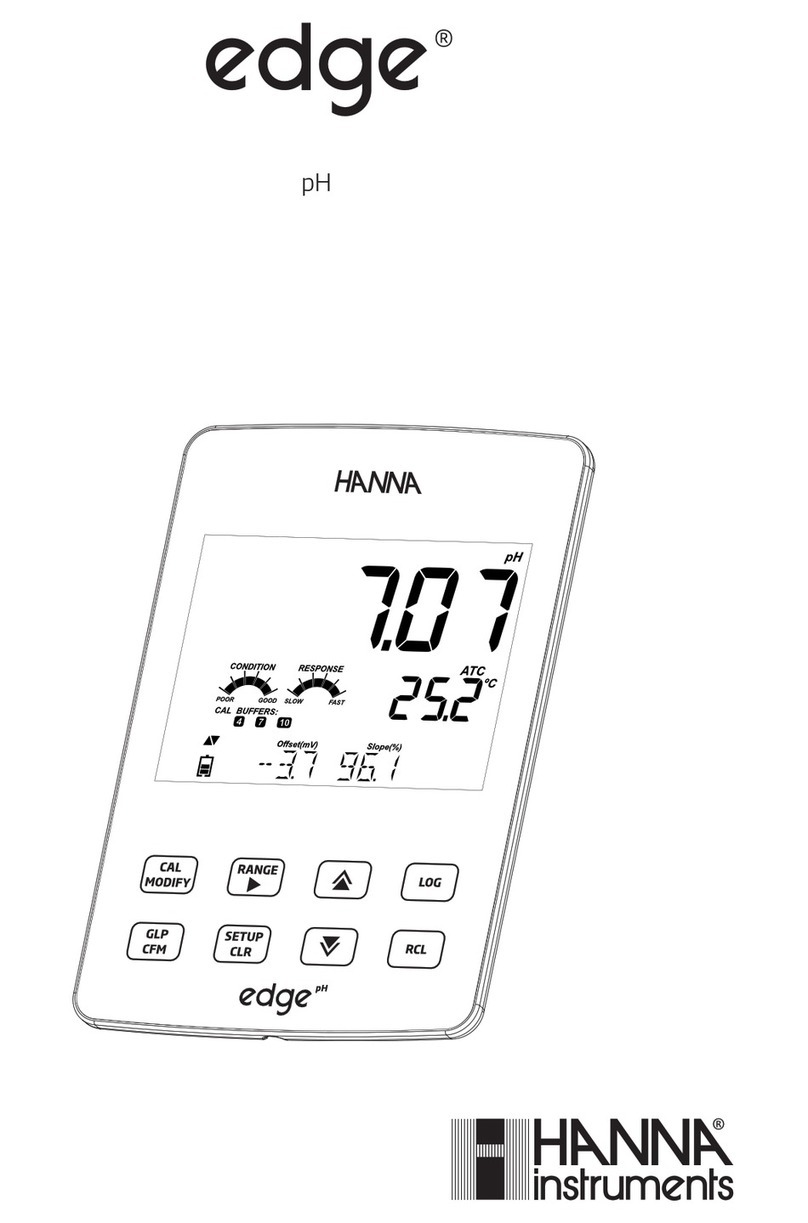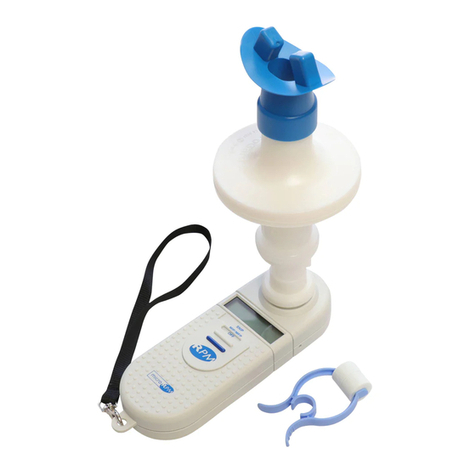GLI International GLI-98144 User manual

Manual No. 98144
Revision 0-401
MODEL GLI-98144
HAND-HELD/PORTABLE
pH/ORP METER

Model GLI-98144 Portable pH/ORP Meter 2 Rev. 0-401
Please read this instruction manual carefully
before using the instrument. This manual will
provide you with all the necessary information
for the correct use of the instrument, as well
as a precise idea of its versatility in a wide
range of applications.
This meter is in compliance with European
Community (CE) directives EN 50081-1 and
EN 50082-1.
TABLE OF CONTENTS
PRELIMINARY EXAMINATION ................................. 2
GENERAL DESCRIPTION .....................................2-3
FUNCTIONAL DESCRIPTION................................... 3
SPECIFICATIONS..................................................... 4
INITIAL PREPARATION............................................ 4
SETUP MODE........................................................ 4-6
TAKING pH MEASUREMENTS................................. 6
TAKING ORP MEASUREMENTS........................... 6-7
TAKING TEMPERATURE MEASUREMENTS ........... 7
pH CALIBRATION PROCEDURE...........................7-8
mV CALIBRATION PROCEDURE .......................... 8-9
TEMPERATURE CALIBRATION PROCEDURE ........ 9
LOGGING FUNCTION ....................................... 10-11
GOOD LABORATORY PRACTICE (GLP) .......... 11-12
LCD BACKLIGHT.................................................... 12
DATA TRANSFER TO PC.................................. 12-13
BATTERY REPLACEMENT ............................... 13-14
TEMPERATURE-RESISTANCE CORRELATION
FOR GLI pH SENSITIVE GLASS........................ 14
ELECTRODE CONDITIONING AND
MAINTENANCE............................................. 15-16
WARRANTY............................................................ 16
PRELIMINARY EXAMINATION
Remove the instrument from the packing
material and examine it carefully to make
sure that no damage has occurred during
shipping. If there is any damage, notify the
transit carrier immediately.
Each meter is supplied complete with:
•GLI-1618D-0 Combination pH Electrode
with built-in temperature sensor
•pH 4.01 buffer
•pH 7.01 buffer
•Instruction Manual
•AA size Alkaline Batteries (four)
•Rugged Carrying Case.
NOTE: Save all packing material until you
are sure that the instrument func-
tions correctly. All defective items
must be returned in their original
packaging together with the supplied
accessories.
GENERAL DESCRIPTION
The GLI-98144 is a portable logging micro-
processor-based pH/ORP/temperature meter.
All pH measurements are automatically com-
pensated for temperature (ATC). The
instrument housing is made of rugged, light-
weight material, making it truly portable.
Five memorized buffers (4.01, 6.86, 7.01,
9.18 and 10.01pH) and wrong buffer recogni-
tion technology make calibration simple and
error free. One or two-point calibration is
possible.
The meters are also equipped with a stability
indicator and backlight feature for comfort-
able reading even in excessively dark
environments. A user friendly interface pro-
vides clear messages regarding errors,
functions and more.
The GLP features provide a guarantee of
data consistency.
Measurements can be performed with labo-
ratory-grade precision in the field as well as
in the laboratory.
An alarm time-out is available to alert the
user if too much time has elapsed since the

Rev. 0-401 3 Model GLI-98144 Portable pH/ORP Meter
last pH calibration and that re-calibration may
be required.
The meter provides a controlled access to
calibration and GLP settings through a pass-
word protection method.
The Battery Error Preventing System (BEPS)
recognizes batteries levels as they become
weaker. To prolong battery life, the backlight
feature is automatically disabled when the
batteries are getting low; a clear indication is
displayed on the LCD to warn the user of this
condition. However, the meter continues to
measure correctly even when the low battery
indication is displayed. The meter automati-
cally switches itself off when the batteries are
too weak to support proper function.
For long term field and lab applications, the
meter can be connected to a 12VDC adapter.
The meter can store measurements in mem-
ory at the request of the user for retrieval at a
later time. It will also allow transfer of data to
a computer through the RS232 port.
In addition, the meter allows the user to enter
an ID code to uniquely identify the instru-
ment.
Made of tough, lightweight ABS material, the
water-resistant rugged casing is built to last.
The meter is in compliance with IP67 stan-
dards: dust-tight, protected against the
effects of temporary immersion in water, and
designed to provide laboratory results and
accuracy under harsh industrial conditions.
FUNCTIONAL DESCRIPTION
(see drawing at right)
1) Power adapter plug
2) RS232 connector
3) Electrode connector
4) Liquid crystal display (LCD)
5) ON/OFF key, to turn the meter on and off
6) ALT key, to alternate key function
7) RANGE/GLP key, to select measurement
ranges, display time and date, and view
calibration data (with ALT key)
8) CAL/CALT key, to enter calibration mode
9)
È
CFM key, to move down or confirm
values (with ALT key)
10) LOG/RCL key, to store measurements or
recall measurements (with ALT key)
11)
Ç
FNC key, to move up or enter setup
mode (with ALT key)
12) LIGHT/DEL key, to turn the LCD back-
light on and off and to delete stored data
(with ALT key)

Model GLI-98144 Portable pH/ORP Meter 4 Rev. 0-401
SPECIFICATIONS
Range pH
mV
Temp.
0.00 to 14.00 pH
± 2000 mV auto-ranging
0 to 80.0°C
Resolution pH
mV
Temp.
0.01 pH
0.1 mV within ± 400mV
1 mV outside this range
0.1°C from -10 to 120°C
1°C below -10°C
Accuracy pH
(@20°C/68°F) mV
Temp.
± 0.01 pH
± 0.2mV within ±400mV
± 0.4mV from+400 to +600mV
± 0.4mV from -400 to -600mV
± 2mV outside these ranges
± 0.4°C from 0 to 70°C
± 1°C outside this range
Typical EMC pH
Deviation mV
Temp.
± 0.02 pH
± 1mV within ±600mV
± 2 mV outside this range
± 0.4°C
pH Calibration Automatic 1 or 2 points with 5
memorized buffers (4.01, 6.86,
7.01, 9.18, and 10.01 pH)
mV Calibration Automatic two points at 0 and
350 mV, or three points at 0,
350, and 1900 mV
Temp. Compensation Automatic 0-80°C (32-176°F)
pH Electrode Amplified, with built-in tem-
perature sensor
ORP Electrode Amplified ORP electrode
Input Impedance 1012 ohm
Power Supply Four 1.5 volt AA alkaline
type/300 hours typical life (with
2700 mA/h batteries, without
backlight); 12 VDC adapter
Casing IP 67
Environment 0 to 50°C/100% RH
Dimensions 7.7 x 3.1 x 2.41 inches
(196 x 80 x 60 mm)
Weight 17.6 oz. (500 g)
INITIAL PREPARATION
Each meter is supplied complete with batter-
ies. Remove the back cover, unwrap the
batteries, and install them while paying atten-
tion to the polarity. Alternatively, connect the
voltage adapter to the power adapter plug.
To prepare the instrument for use, connect
the pH or ORP electrode to the connector lo-
cated on the top of the instrument.
To switch the meter on, press the ON/OFF
key. The batteries charge status or "LINE"
message (if external power adapter is con-
nected) will be displayed on
the LCD for a few seconds.
The meter is now ready to
operate.
To maximize battery life, the meter is auto-
matically switched off after 5 minutes of non-
use (feature is enabled by default and can be
disabled through setup code 20). To reacti-
vate the instrument, press the ON/OFF key.
Before proceeding with pH measurements,
follow the calibration procedure.
NOTE: When using an alternate function
(DEL, FNC, CFM, GLP, RCL and
CALT), press and hold the ALT key
first and then the second listed key.
CAUTION
TO PREVENT DAMAGE TO THE
ELECTRODE, REMOVE THE pH
ELECTRODE FROM THE SAMPLE
BEFORE TURNING THE METER OFF. IF
THE METER IS OFF, DETACH THE
ELECTRODE FROM THE METER
BEFORE IMMERSING THE ELECTRODE
IN THE STORAGE SOLUTION.
SETUP MODE
Setup can be used to view data regarding in-
strument status (e.g. battery charge) or to
change the meter parameters (e.g. time).
•To enter this mode press
the ALT and FNC keys
when the meter is in
measurement mode.
•The setup code "00" will
blink on the lower LCD
and "Set" will be dis-
played on the upper one.
•Select the code of
desired parameter
using
Ç
or
È
key.

Rev. 0-401 5 Model GLI-98144 Portable pH/ORP Meter
•Press ALT and CFM to
confirm the code.
NOTE: If ALT and FNC are pressed before
code confirmation, the meter will
default to measurement mode.
If the selected parameter is password pro-
tected, the lower LCD will display "PAS" and
the password must be entered to proceed.
Otherwise, the current parameter value will
be displayed.
PASSWORD PROTECTION
Setting of time, date, and calibration alarm
time-out are password protected, and the
user will be asked to enter the password to
change these parameters. After code confir-
mation, the upper LCD will display "0000."
•If password is set to 0000 (factory set-
ting), just press ALT and CFM to confirm.
•If password is set to a value different from
0000, enter the password with the up and
down arrow keys and then press ALT and
CFM to confirm.
•If password is incorrect, the meter dis-
plays the "WRONG" indication and asks
for the password again.
•If password is correct, the meter provides
access to the parameter.
PARAMETER SETTINGS
Once the parameter code
(and password, if needed)
has been entered, the cur-
rent value of the selected
parameter on the upper LCD and the pa-
rameter code on the lower LCD will be
displayed. The parameter or a part of it will
blink (e.g. only the hour blinks if time has
been selected).
•Enter the new
value using the ar-
row keys.
If there is another part of the parameter to
be set (e.g. minutes for the time), press
RANGE to gain access and then enter the
new value using the arrow keys.
Press ALT and CFM to confirm the value.
•If the entered value is not acceptable, the
"WRONG" indication will be displayed for
a few seconds and then the meter will ask
for a correct value.
•If the confirmed value is accepted, the
meter will pass to the next parameter
(asking for the password if it is protected).
NOTE: If ALT and FNC are pressed before
parameter value confirmation, the
meter will not update the parameter
and, after escaping, will ask for a
new setup code.
The following table lists the setup codes
along with the description of the specific
setup items, their valid values and the factory
settings (default):
Code Valid values Default
00 Instrument ID code 0000-9999 0000
01 Current time1hh:mm 00:00
02 Current date1dd:mm 01:01
03 Current year1YYYY 1998
10 Calibration alarm
time-out
01-99 days, OFF 07
20 Auto-Off/Power down
time-out
ON, OFF ON
21 Firmware version
22 Battery level test
99 Password20000-9999 0000
1The meter automatically checks for entered time/date ac-
curacy as follows:
0≤hh≤23; 0≤mm≤59; 01≤dd≤28/29/30/31; 1MM≤12;
1998≤YYYY≤2097.
2To change the password, the correct code must be en-
tered first. If the password has been forgotten, the
password protected features are no longer accessible. In
this case, contact the GLI International Service Dept.

Model GLI-98144 Portable pH/ORP Meter 6 Rev. 0-401
Some of the setup parameters are explained
below:
Code 00: Setting the identification (ID) code.
When using several identical meters it may
be useful to uniquely identify them by as-
signing an ID code to each meter.
•Select code 00.
•Enter a 4-digit value using the arrow keys.
•Press ALT and CFM to confirm the value.
Code 20: Auto-off. The auto-off timeout is
fixed at 5 minutes.
•Select code 20 to enable/disable this
feature.
Code 22: Battery level test.
•Select code 22.
If the meter is connected
to an external power
adapter, the LCD will
display "LINE." Other-
wise it will display "bAtt" on the upper dis-
play, and the remaining percentage of
battery charge (100% means fully
charged battery; 0% means the minimum
battery voltage that allows the meter to
operate).
NOTE: The battery level test is also per-
formed any time the meter is
turned on.
TAKING pH MEASUREMENTS
Connect the pH electrode to the
connector and press ON/OFF.
For greatest accuracy, it is recommended to
set the Calibration alarm time-out to the value
appropriate to your specific use and calibrate
the meter as soon as the
"DATE" warning symbol
blinks on LCD (see GLP
section).
To take pH measurements, simply submerge
the bottom 4 cm (1½inches) of the electrode
in the solution to be tested and stir gently.
Allow for the reading to stabilize. The tem-
perature is displayed in the lower LCD.
The pH reading is automatically temperature
compensated (ATC). If the meter displays
"----" it means that the reading is out of range.
A blinking reading means that the electrode is
"dead." By continuously pressing the RANGE
key the following information will be displayed
on the upper LCD:
•mV reading which is auto-ranging. When
the reading is outside ±600mV the deci-
mal point automatically disappears.
•Time
•Day - Month
•Year
Pressing RANGE again, the meter returns to
pH reading.
NOTE: When date or time is displayed, it is
possible to change them pressing
ALT and FNC with no need to enter
setup mode.
If measurements are taken succes-
sively in different samples, it is
recommended to rinse the electrode
thoroughly with deionized water or, if
not available, tap water first and then
with some of the next sample to
condition the electrode before im-
mersing it in the sample.
TAKING ORP MEASUREMENTS
Connect the ORP electrode to the meter and
press the ON/OFF key.
If the ORP electrode is not connected the
LCD will display the "no probe" message and
then dashed lines in place of the readings.
To take ORP measurements, simply sub-
merge the bottom 4 cm (1½inches) of the

Rev. 0-401 7 Model GLI-98144 Portable pH/ORP Meter
ORP electrode in the solution to be tested,
stir gently and allow for the reading to stabi-
lize.
NOTE: The ORP electrode does not have a
built-in temperature sensor.
By continuously pressing the RANGE key the
following information will be displayed on the
upper LCD:
•Time
•Day - Month
•Year
Pressing RANGE again, the meter returns to
mV reading.
NOTE: If measurements are taken succes-
sively in different samples, it is
recommended to rinse the electrode
thoroughly with deionized water or, if
not available, tap water first and then
with some of the next sample to
condition the electrode before im-
mersing it in the sample.
TAKING TEMPERATURE MEASUREMENTS
The temperature sensor is integrated in the
pH electrode.
Immerse the pH electrode in the solution (al-
low a few minutes for the temperature to
stabilize) and press the ON/OFF key. The
temperature is displayed in the lower LCD.
NOTE: If temperature measurement is out of
range the LCD will display " - - -".
pH CALIBRATION PROCEDURE
For greatest accuracy, it is recommended
that the instrument is calibrated frequently.
For a faster procedure, it is possible to cali-
brate at 1 point, but it is always a good
practice to calibrate at 2 points.
A two-point calibration can use any combina-
tion of the three buffer sets:
(4.01) (6.86/7.01) (9.18/10.01)
Only one value from each set can be select-
ed. For example if pH 7.01 is used as the first
point, it will not be possible to select pH 6.86
as the second point.
In the case of a two-point calibration (in the
acidic range) from 0 to 7 pH, use pH buffer
7.01 (or 6.86) as the first solution and pH
buffer 4.01 as the second solution. If testing
in the alkaline range from 7 to 14 pH, use pH
buffer 10.01 (or 9.18) as the second solution.
Due to electrode conditioning time, the elec-
trode must be kept immersed a few seconds
to stabilize. The meter is equipped with a
stability indicator and the user will be guided
step-by-step with easy indications on the
LCD during the calibration. This will make the
calibration a simple and error-free procedure.
pH CALIBRATION
1. Rinse the electrode with a portion of the
first calibration buffer or clean water. Dip
the bottom 4 cm (1½inches) of the elec-
trode into a beaker containing the
solution.
2. Press CAL when the meter
displays pH measurement.
3. Enter the password (if different from
"0000") with the arrow keys.
4. Press ALT and CFM to
confirm the password
or CAL to exit.
5. If password is correct, the meter displays
"7.01pH" on the lower LCD with the "BUF
1" and "CAL" indication.
The upper LCD shows
the uncalibrated pH
reading.

Model GLI-98144 Portable pH/ORP Meter 8 Rev. 0-401
NOTE: The buffer pH value, and thus
the value displayed on the lower
LCD, varies with temperature.
For example, at 20°C it shows
4.00, 7.03 or 10.06. At 25°C it
shows 4.01, 7.01 or 10.01.
6. Select the first buffer solution value with
Ç
DQG
È
key if necessary.
7. When the "CFM" sym-
bol blinks, the reading
is stable and calibration
can be confirmed.
8. Press ALT and CFM to confirm the first
buffer.
9. If everything is satisfac-
tory, the LCD will display
"Stor" and then the
second buffer value ex-
pected will be displayed
(two-point calibration). If
a wrong solution or
electrode has been
used, or if the buffer is polluted,
"WRONG" will be displayed to alert the
user.
10. If only a single point cali-
bration is required, press
CAL to leave the calibra-
tion mode and maintain the
previous slope calibration. The instru-
ment then checks the electrode
parameters and advises user of abnor-
malities by "old probe" and "dead probe"
indications.
11. Press
Ç
or
È
to select
the second buffer value.
The meter will display
the "BUF 2" indication.
12. Rinse the electrode with some of the
second buffer solution or clean water.
13. Dip the bottom 4 cm (1½inches) of the
pH electrode in a beaker containing the
second buffer.
14. When the "CFM" sym-
bol blinks, press ALT
and CFM to confirm the
second calibration point.
15. The LCD will display "Stor." The instru-
ment checks the electrode parameters
and advises the user of abnormalities by
"old probe" and "dead probe" indications
(in these cases, repeat the calibration
with fresh buffers). If everything is satis-
factory the meter is calibrated and it
returns to normal operational mode.
CALIBRATION ERROR MESSAGES
If the "old probe," "dead probe" or "WRONG"
messages are displayed during calibration,
check your electrode by following the condi-
tioning and maintenance procedures and
repeat calibration. The pH electrode might
have to be replaced if calibration cannot be
successfully performed.
NOTE: See "GLP" paragraph for more de-
tails about "old probe" and "dead
probe" messages.
mV CALIBRATION
A two or three-point calibration can be per-
formed. The first two calibration points are
always 0 and +350 mV; the third point is op-
tional at +1900 mV.
1. Connect a mV simulator to the meter and
set it to 0 mV.
2. Press CAL when LCD is
displaying mV.
3. Enter the password (if different from
"0000") with the arrow keys.
4. Press ALT and CFM to confirm the
password or CAL to exit.
5. If password is correct, the meter will dis-
play "0 mV" on the lower LCD with the

Rev. 0-401 9 Model GLI-98144 Portable pH/ORP Meter
"BUF 1" and "CAL" in-
dication. The upper
LCD displays the mV
reading.
6. When the "CFM" sym-
bol blinks, the reading
is stable and calibra-
tion can be confirmed.
7. Press ALT and CFM to
confirm the first value.
8. The LCD will display
"Stor" for a few sec-
onds.
9. The meter will then dis-
play "350 mV" on the
lower LCD with the
"BUF 2" indication.
10. Set the simulator to +350 mV.
11. When the "CFM" sym-
bol blinks, the reading
is stable. Press ALT
and CFM to confirm
the second value.
12. The LCD will display "Stor" for a few
seconds.
13. If only a two-point calibration is required,
press CAL to leave the calibration mode.
Proceed with the next step for three-point
calibration.
14. The meter will display
"1900 mV" on the lower
LCD with the "BUF 3"
indication.
15. Set the simulator to
1900 mV.
16. When the "CFM" symbol blinks, the
reading is stable. Press ALT and CFM to
confirm the third value.
17. Calibration is now complete, the instru-
ment returns to normal operational mode.
NOTE: "WRONG" message notifies the user
if the selected value is wrong.
TEMPERATURE CALIBRATION
PROCEDURE
(for technical personnel only)
A two-point calibration at 0.0°C and 50.0°C
has to be performed in order to store the new
calibration data in memory.
1. Immerse the pH electrode with the built-
in temperature sensor in the 0°C tem-
perature bath.
2. Press ALT and CALT to enter tempera-
ture calibration mode.
3. Enter the password.
4. The meter will display "0.0°C" on the
lower LCD with the "BUF 1" and "CAL"
indication.
5. When the reading is stable the "CFM"
symbol starts to blink.
6. Press ALT and CFM to confirm. LCD will
then display 50.0°C on the lower LCD
with the "BUF 2" indication.
7. Immerse the pH electrode with the built-
in temperature sensor in the 50°C tem-
perature bath.
8. When the reading is stable the "CFM"
symbol starts to blink.
9. Press ALT and CFM to confirm and re-
turn to normal operational mode.

Model GLI-98144 Portable pH/ORP Meter 10 Rev. 0-401
LOGGING FUNCTION
To store the current reading in memory,
press the LOG key while in measurement
mode. The LCD will display "Stor" along with
the "LOG" indication and the sample number
for a few seconds.
By pressing the LOG key, a complete set of
information is memorized:
•Date/time
•pH and mV readings
•Temperature reading
•A message on the meter status.
Up to 500 samples can be
stored into memory. When
the memory is full and the
LOG key is pressed, the
sample will not be stored and the LCD will
display "FULL." In this case, it is necessary to
delete all the memory to proceed.
TO VIEW LOGGED DATA
To retrieve the memo-
rized information, press
ALT and RCL.
The meter displays the date
(upper LCD) and the
number (lower LCD) of the
last logged sample. The
"ZERO" indication will be displayed if no
samples are stored in memory.
•Select the desired sample number with
the arrow keys. Pressing the
Ç
key while
the last sample is displayed causes the
meter to go to the first sample.
•Press RANGE to view
remaining data of the se-
lected sample. After the
date information, the re-
maining data will be displayed in the fol-
lowing order:
- Year
- Time
-pH reading: "----" means reading out of
range or no probe
was connected.
"OrP" means that
an ORP electrode
was connected.
-mV reading: "----"
means reading out
of range.
-Temperature read-
ing: "----" means
reading out of
range.
-GLP mes-
sage
If RANGE is pressed when the GLP message
is displayed, the LCD will revert to the date of
the viewed sample.
It is always possible to skip to another sam-
ple using the up and down arrow keys. For
example, if the pH reading of a sample is dis-
played, pressing the up arrow key will cause
the meter to display the pH reading of the
next sample.
At any time it is possible to return to normal
operational mode by pressing ALT and RCL.

Rev. 0-401 11 Model GLI-98144 Portable pH/ORP Meter
TO DELETE LOGGED DATA
It is possible to delete a single sample or all
the memory at one time.
To delete a single sample:
•Enter the viewing logged data mode and
select the desired sample number.
•Press ALT and DEL.
The "CFM" indication
will start blinking asking
for confirmation.
•Press the ALT and
CFM to confirm deletion.
NOTE: Press ALT and DEL. to escape
without data deletion. When
viewing through the logged data,
the "NUL" message will be dis-
played when selecting a deleted
sample.
To delete all data in memory:
•Press ALT and DEL
while in normal opera-
tional mode. The "del
All" message will scroll
on the LCD and the "CFM" indication will
start blinking asking for confirmation.
•Press ALT and CFM to
confirm deletion.
NOTE: Press ALT and
DEL to escape
without data
deletion.
If no samples are stored in mem-
ory and a deletion is attempted,
the meter will show the message
"Zero" and then returns to normal
operational mode.
GOOD LABORATORY PRACTICE (GLP)
GLP is a set of functions that allows the stor-
age or retrieval (when necessary) of data
regarding the maintenance and status of the
electrode. The meter can automatically ana-
lyze the data and advise the user with a clear
message if a problem is found.
PROBE LIFE VERIFICATION
At the end of calibration, the meter checks if
offset is between -30 and +30 mV and the
slope between 53.5 and 62 mV/pH. If the val-
ues are not within these parameters, the
message "old probe" scrolls across the LCD.
The electrode is still working, but it will be
necessary to perform a cleaning procedure
(see electrode cleaning and maintenance
paragraph) or replace it.
If the offset is outside the -60 and +60 mV
range or the slope is outside the 40 to 70
mV/pH interval, the "dead probe" message
will scroll across the LCD. The readings will
blink on the upper LCD to warn the user that
they are not reliable.
CALIBRATION ALARM TIME-OUT
The calibration alarm time-out is available
only for pH calibration. It is possible to set
(through setup code 10) the number of days
before the next required calibration proce-
dure. The user can set a value from 01 to 99
days. The default value is 07. Set the pa-
rameter to "OFF" to disable this feature.
When turned on, the meter
checks if the time-out time
has expired. If the time has
run out, the message "Cal
date" scrolls across the LCD. The "DATE"
symbol will blink as a reminder.
Alarm time-out is also signaled when viewing
logged data through the "Cal date" message.
GLP AND RS232
All the GLP data can be retrieved (if the elec-
trode is connected) from a PC through the
RS232 communication feature. The calibra-
tion data are transferred to the PC along with

Model GLI-98144 Portable pH/ORP Meter 12 Rev. 0-401
measurement data (see "Data transfer to PC"
paragraph).
LAST CALIBRATION DATA
Last calibration data are stored automatically
after a successful calibration and they can be
displayed by pressing the GLP key. To view
pH calibration data:
•Press ALT and GLP
when the meter displays
pH reading. The LCD will
then display the last pH
calibration date.
•Press RANGE to scan remaining data, in
the following order:
-last calibration time
-electrode offset value in mV ("OFF" ap-
pears in the lower LCD)
-electrode slope in mV/pH ("SLP" ap-
pears in the lower LCD)
-first point calibration buffer
-second point calibration buffer (only if a
2-point calibration has been performed)
If calibration was performed with an old or
dead probe, the message "Old probe" or
"Dead probe" will scroll on LCD. The meter
will then return to normal operational mode.
Press ALT and GLP to escape before viewing
all the data.
To view mV calibration data:
•Press ALT and GLP when the meter dis-
plays mV reading. The LCD will then
display the last mV calibration date.
•Press RANGE to scan remaining data, in
the following order:
-last calibration time
-first calibration point
-second calibration point
-third calibration point (only if a 3-point
calibration has been performed)
The meter will then return to normal opera-
tional mode. Press ALT and GLP to escape
before viewing all the data.
LCD BACKLIGHT
The LCD can be illuminated
to allow the user to see the
readings even in dark envi-
ronments. It can be enabled/
disabled through the LIGHT key and it is
automatically disabled when batteries are in
low battery condition.
Two levels (low and high) of backlighting can
be selected. Repeatedly pressing the LIGHT
key causes the lighting to cycle from off to
low then to high intensity.
NOTE: It is not possible to enable backlight
in low battery condition; the "Batt" in-
dication will be displayed when trying
to do so.
When the backlight is enabled and
an external power supply is con-
nected to the instrument, the
backlight is always on.
DATA TRANSFER TO PC
Press RANGE to set the meter to time or
date mode, and connect the meter to a PC
through the RS232C output (the connector is
located on the top of the meter). Use a 5 to 9-
pin connection cable.
To stop communication, press RANGE to
display pH or mV reading.
SPECIFICATIONS:
Isolated 8-bit data
transmission
Baud Rate: 2400
Start bit: 1
Stop bit: 1
Parity bit: none
SENDING COMMANDS FROM PC
With any terminal programs it is possible to
remotely control your pH meter. Connect the

Rev. 0-401 13 Model GLI-98144 Portable pH/ORP Meter
meter to the PC through the cable, start the
terminal program and set the communication
options as follows: 8, N, 1, no flow control.
To send a command to the pH meter, the
scheme is:
<command>
<CR>
The computer sends the command ex-
pressed as a 3-character sequence and a CR
character.
NOTE: All the terminal programs that sup-
port the ANSI escape sequence,
represent the CR character with the
string '^M.'
The commands available are as follows:
MOD - to request the firmware code of the
meter.
GLP - to request the last calibration data.
The meter answers with the follow-
ing order:
pH calibration status (0=not cali-
brated, 1=calibrated)
pH calibration date (ddmmyy)
pH calibration time (hhmm)
pH electrode offset
pH electrode slope
pH buffer 1
pH buffer 2
mV calibration status (0=not cali-
brated, 1=calibrated)
mV calibration date (ddmmyy)
mV calibration time (hhmm)
mV buffer 1
mV buffer 2
mV buffer 3
If an item is not available (e.g. buf 3
in case of a two points mV calibra-
tion) the character "N" will be
received.
PAR - to request the setup parameters
setting.
The meter answers with a 6-
character string for each parameter.
LTB - to request the number of logged
samples.
LOD - to request the logged data.
The meter answers with the follow-
ing order:
status byte
date (ddmmyy)
time (hhmm)
pH reading (binary)
mV reading (binary)
temperature reading (binary)
At the end of the logged data the
checksum (2 complement) is sent.
NOTE: The meter will send <CAN> if a cor-
rupted or unknown command is
received.
These commands may be sent with either
capital or small letters. Invalid commands will
be ignored. The characters sent by the pH
meter are always capital letters.
BATTERY REPLACEMENT
When the batteries are inserted and no
power adapter is connected, the meter can
recognize different batteries charge levels.
1. Fully charged batteries -- The backlight
can be enabled.
2. Weakening batteries -- The backlight is
automatically disabled and it is not pos-
sible to enable it until new batteries are
inserted or an external power adapter is
connected. The "Batt" indication appears
when trying to enable backlight.

Model GLI-98144 Portable pH/ORP Meter 14 Rev. 0-401
3. Weak batteries -- "Bat" indication is dis-
played on lower LCD alternating the
temperature reading. Backlight is dis-
abled and meter can work for about 10
hours.
4. Dead batteries -- LCD shuts off. The in-
strument stops working to avoid
erroneous readings.
Battery replacement must
only take place in a non-
hazardous area using
1.5V alkaline AA type
batteries. To replace run-
down batteries, simply
remove the two screws on
the rear cover of the in-
strument and replace the
four 1.5V AA batteries
with new ones, observing
correct polarity. A 12 VDC
power adapter can also be used to power the
unit.
NOTE: The instrument uses the following
configuration.
It is recommendable to purchase the GLI
voltage adapters that use the proper polarity
configuration. However, the meter can be
used with other adapters. In this case, re-
member to check the correct polarity of your
adapter before connecting it to the meter.
TEMPERATURE-RESISTANCE
CORRELATION
FOR GLI pH SENSITIVE GLASS
The resistance of glass electrodes partially
depends on the temperature. The lower the
temperature, the higher the resistance. It
takes longer time for the reading to stabilize if
the resistance is higher. In addition, the re-
sponse time will suffer to a greater degree at
temperatures below 10°C.
Since the resistance of the pH electrode is in
the range of 200 Mohm, the current across
the membrane is in the pico-Ampere range.
Large currents can disturb the calibration of
the electrode for many hours.
For these reasons, high humidity environ-
ments, short circuits, and static discharges
are detrimental to a stable pH reading.
The pH electrode's life also depends on the
temperature. If constantly used at high tem-
peratures, the electrode life is drastically
reduced.
Typical Electrode Life
@ Ambient Temp.............................1-3 years
90°C.................................Less than 4 months
120°C.................................Less than 1 month
High concentrations of sodium ions interfere
with readings in alkaline solutions. The pH at
which the interference starts to be significant
depends upon the composition of the glass.
This interference is the alkaline error and
causes the pH to be underestimated. GLI's
glass formulations have the following char-
acteristics:

Rev. 0-401 15 Model GLI-98144 Portable pH/ORP Meter
ELECTRODE CONDITIONING
AND MAINTENANCE
NOTE: To prevent damage to the electrode,
remove the pH electrode from the
sample before turning the meter off.
If the meter is OFF, detach the
electrode from the meter before im-
mersing the electrode in the storage
solution.
PREPARATION
Remove the protective cap. DO NOT BE
ALARMED IF SALT DEPOSITS ARE
PRESENT. This is normal with electrodes
and they will disappear when rinsed with
water.
During transport, tiny bubbles of air may form
inside the glass bulb. The electrode cannot
function properly under these conditions.
These bubbles can be removed by "shaking
down" the electrode as you would do with a
glass thermometer.
If the bulb and/or junction are dry, soak the
electrode in pH 7.01 buffer for at least one
hour.
MEASUREMENT
Rinse the electrode tip with distilled water.
Immerse the tip (4 cm/1½inches) in the
sample and stir gently for approx. 30 sec-
onds.
For a faster response and to avoid cross
contamination of the samples, rinse the elec-
trode tip with a few drops of the solution to be
tested, before taking measurements.
STORAGE
To minimize clogging and ensure a quick re-
sponse time, the glass bulb and the junction
should be kept moist and not allowed to dry
out.
Replace solution in the protective cap with a
few drops of pH 7.01 buffer. Follow the
PREPARATION procedure described previ-
ously before taking measurements.
CAUTION:
NEVER STORE THE ELECTRODE DRY
OR IN DISTILLED WATER.
PERIODIC MAINTENANCE
Inspect the electrode and the cable. The ca-
ble used for connection to the meter must be
intact and there must be no points of broken
insulation on the cable or cracks on the elec-
trode stem or bulb. Connectors must be
perfectly clean and dry.
If any scratches or cracks are present, re-
place the electrode.
Rinse off any salt deposits with water.
CLEANING PROCEDURE
General Cleaning: Soak in warm soapy water
for approximately 1 hour.
Removal of films, dirt or deposits on the glass
bulb/junction:
-
Proteins:
Soak in a protein cleaning
solution for 15 minutes.
-
Inorganics:
Soak in an inorganic cleaning
solution for 15 minutes.
-
Oil/grease:
Rinse with an oil and fat
cleaning solution.
NOTE: After performing any of the cleaning
procedures, rinse the electrode thor-
oughly with distilled water, and soak
the electrode in pH 7.01 buffer for at
least 1 hour before taking measure-
ments.
TROUBLESHOOTING
Evaluate your electrode performance based
on the following possibilities:

Model GLI-98144 Portable pH/ORP Meter 16 Rev. 0-401
•Noise (readings fluctuate up and down)
could be due to a clogged/dirty junction.
Refer to the CLEANING PROCEDURE
above.
•Dry Membrane/Junction: Soak in pH 7.01
buffer for at least 1 hour.
•Drifting: Soak the electrode tip in warm
soapy water for one hour, then flush tip
with distilled water.
•Low Slope: Refer to the CLEANING
PROCEDURE above.
•No Slope: Check the electrode for cracks
in glass stem or bulb and replace the
electrode.
•Slow Response/Excessive Drift: Soak the
tip in warm soapy water for 30 minutes,
rinse thoroughly in distilled water and then
follow the Cleaning Procedure above.
WARRANTY
GLI International, Inc. warrants the Model
GLI-98144 Hand-held/Portable pH/ORP Me-
ter to be free from defects in material or
workmanship for a period of one year (12
months) from the date of shipment of this
product from our facility. The GLI-1618D-0
Combination Electrode is warranted for a pe-
riod of 6 months. A warranty claim will not
be honored if defects are not reported within
the warranty period, or if GLI International
determines that defects or damages are due
to normal wear, misapplication, lack of main-
tenance, abuse, improper installation,
alteration or abnormal conditions. GLI Inter-
national’s obligation under this warranty shall
be limited to, at its option, replacement or re-
pair of this product. The product must be
returned to GLI International, freight prepaid,
for examination. The product must be thor-
oughly cleaned and any process chemicals
removed before it will be accepted for re-
placement or repair. GLI International’s
liability shall not exceed the cost of the prod-
uct. Under no circumstances will GLI
International be liable for any incidental or
consequential damages, whether to person
or property. GLI International will not be liable
for any other loss, damage or expense of any
kind, including loss of profits, resulting from
the installation, use, or inability to use this
product.
Table of contents
Other GLI International Measuring Instrument manuals
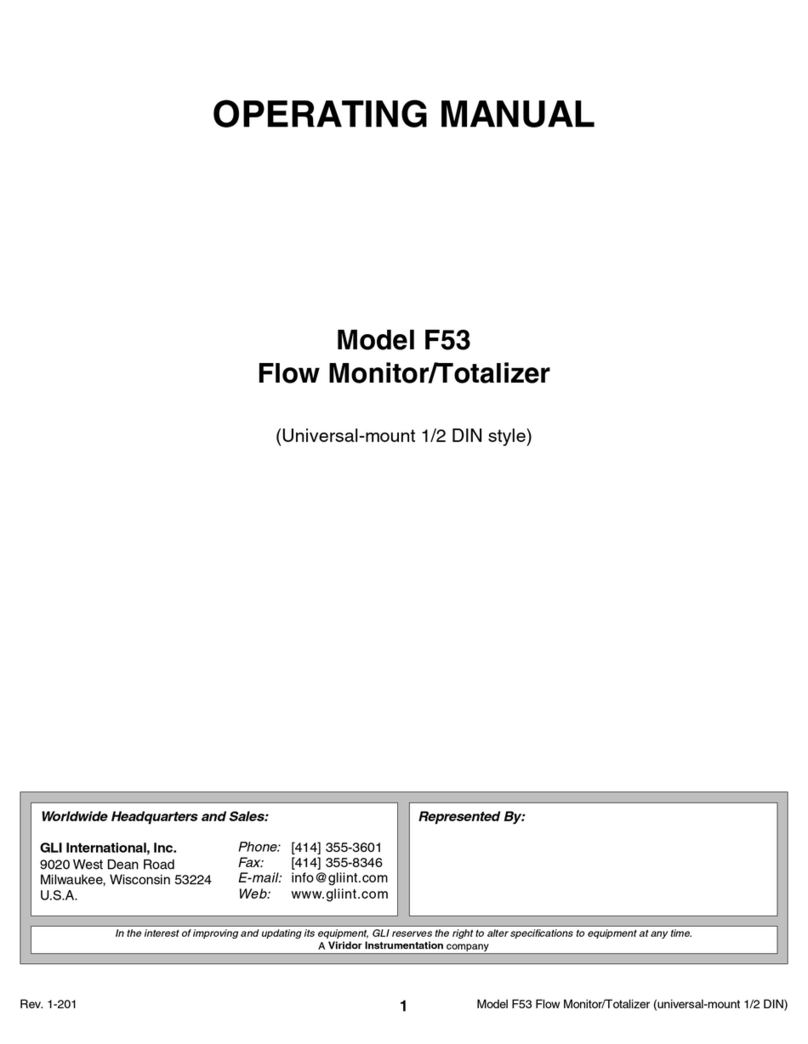
GLI International
GLI International F53 User manual
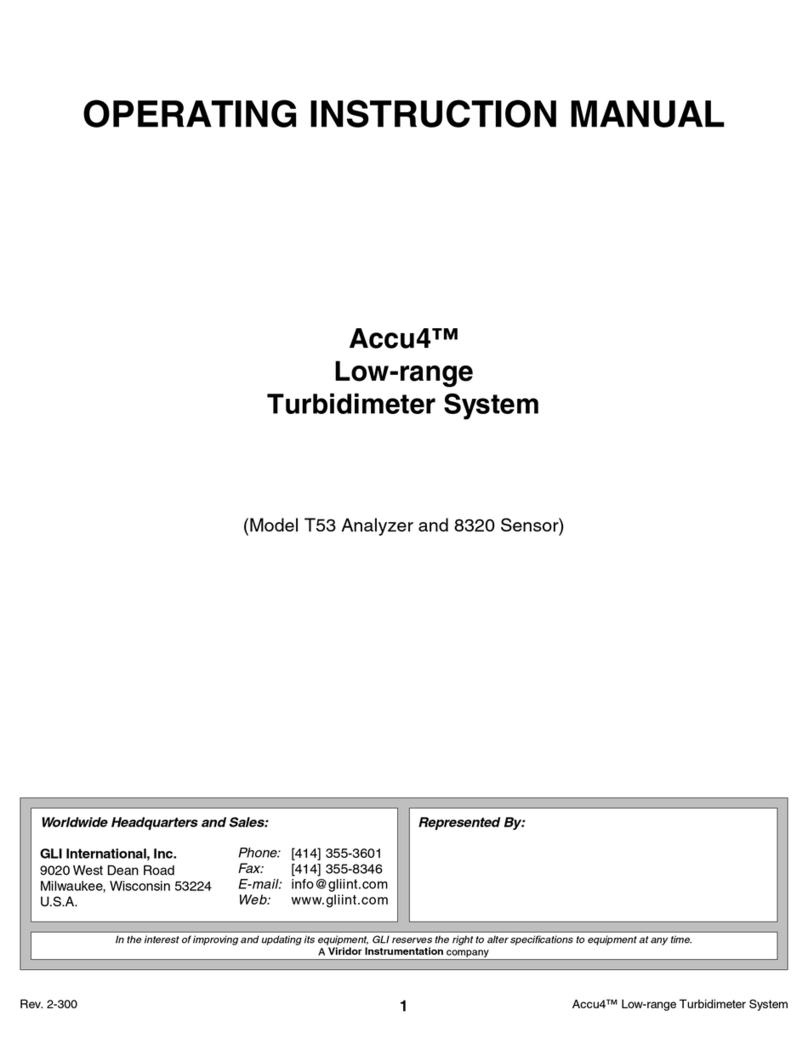
GLI International
GLI International Accu4 Instruction Manual

GLI International
GLI International GLI-9143 User manual

GLI International
GLI International P33 Instruction Manual

GLI International
GLI International GLI-93711 User manual

GLI International
GLI International C53 Instruction Manual

GLI International
GLI International P53 Instruction Manual
